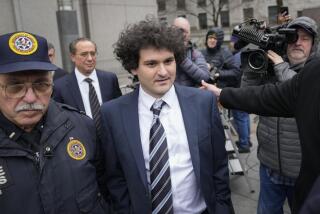Business Bookshelf: ‘Crash of the Titans’
- Share via
While vast swaths of events of the financial crisis have been minutely chronicled, particularly the collapse of Lehman Bros., the people and culture have remained largely unanalyzed. The executives at the center of the crisis have been portrayed as supermen or cartoon villains.
Greg Farrell ably remedies these flaws in an immaculately reported book, “Crash of The Titans: Greed, Hubris, the Fall of Merrill Lynch and the Near-Collapse of Bank of America.” It traces the paths of Bank of America Corp. and Merrill Lynch & Co. — and their hapless executives — to their awkward, unhappy and litigious marriage.
The book, published by Crown Business, is an easy read, avoiding tortured financial definitions to focus instead on the story of the personalities involved. It will appeal to both intelligent lay readers and financial professionals.
Farrell, who covered the financial crisis for the Financial Times, has found one of the biggest untold stories of the drama: how a proud, century-old company like Merrill Lynch destroyed itself through risky investments and had to beg Bank of America to buy it.
Farrell tells it in entertaining detail, with attention to the chronology and the motivations of the important players. The enormous reporting that it must have taken is evident: He interviewed 120 people, and he pieces together more from documents and e-mails both public and private.
The most remarkable passages are often despairing internal dialogues from former executives including Merrill Lynch chief executives Stanley O’Neal and John Thain, BofA CEO Ken Lewis and Merrill Lynch President Greg Fleming.
The narrative is simple, if horrifying, to follow: Merrill Lynch executives were blind to the doings of their fixed-income department.
While the company’s leaders thought they were selling off their disastrous exposure to collateralized debt obligations, or CDOs, in fact the firm had increased its exposure by eight times — simply so that some traders and executives could claim they generated higher fees for higher bonuses.
There is a strong hint of a romantic comedy as Merrill Lynch and Bank of America profess their hatred of each other — hillbillies on the one side, money-grubbers on the other — then, of course, fall into bed with each other.
All along, though, they are plagued by vanity. On more than one occasion, Merrill Lynch and Bank of America are shown to have so little cohesion and solidity that news stories destroy their leadership. The ousting of Merrill board member John Finnegan, who opposed big bonuses, came about because he was alleged to have leaked Thain’s bonus to the Wall Street Journal.
The chief and overwhelming virtue of “Crash of the Titans” is this: There are no heroes, no manufactured villains.
Each of the executives is shown in moments of glory and despair. Their lack of communication and refusal to confront reality is inevitably disastrous. In every chapter these powerful men exhibit caprice, folly and petulance as well as some noble moments.
The only true malefactors in the book are Wall Street’s bonus-obsessed culture and the trend of shareholder institutions behaving like private fiefdoms.
The greatest revelation is that Merrill Lynch, which its founders built on “the modest sums of the thrifty,” grows to structure itself like the CDOs that nearly destroyed the bank: with hard-to-value and built-in confusing tranches with little connection among them.
The long-held mysteries of Merrill’s last-minute bonus payments and write-downs are admirably explained.
“Crash of the Titans” is a heavy volume at more than 450 pages, but it is well paced. It is peppered with tantalizing tidbits like Larry Fink, CEO of BlackRock, responding to not getting the top job at Merrill Lynch by cursing at a board member.
It’s surprising to discover that Thain essentially staged a sit-in at a Bank of America board meeting to protect his team’s bonuses, only to have them all taken away.
And what about Steele Alphin, Bank of America’s chief administrative officer, casually threatening Merrill’s Fleming by comparing BofA to a wolf, clawing the air, snapping his teeth and warning through a smile: “The wolf is hungry. He’ll git you.” There is no better example of why Merrill feared the “Beverly Hillbillies” at the bank in North Carolina.
“Crash of the Titans” also avoids another trap of the financial crisis sub-genre: It is not overwritten. It makes good use of dramatic irony, in which the reader knows what will happen but the characters don’t yet.
Take, early on, one Merrill executive’s concerned question to another while looking at the bank’s books: “Is that all the subprime you have?” When, of course, the reader knows in hindsight that the bank will have to claim billions more in subprime losses.
Farrell doesn’t patronize the reader by spelling out the ironies. The reader can fill in the impending doom. It is useful, however, to have enough information and insight to be able to get the whole story.
Heidi Moore is a New York-based contributor to the Financial Times of London, in which this review first appeared.
More to Read
Sign up for our Book Club newsletter
Get the latest news, events and more from the Los Angeles Times Book Club, and help us get L.A. reading and talking.
You may occasionally receive promotional content from the Los Angeles Times.










